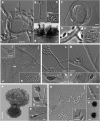Molecular and phenotypic characterization of Phialemonium and Lecythophora isolates from clinical samples
- PMID: 21270235
- PMCID: PMC3122869
- DOI: 10.1128/JCM.01979-10
Molecular and phenotypic characterization of Phialemonium and Lecythophora isolates from clinical samples
Abstract
Several members of the fungal genera Phialemonium and Lecythophora are occasional agents of severe human and animal infections. These species are difficult to identify, and relatively little is known about their frequency in the clinical setting. The objective of this study was to characterize morphologically and molecularly, on the basis of the analysis of large-subunit ribosomal DNA sequences, a set of 68 clinical isolates presumed to belong to these genera. A total of 59 isolates were determined to be Phialemonium species (n = 32) or a related Cephalotheca species (n = 6) or Lecythophora species (n = 20) or a related Coniochaeta species (n = 1). Nine isolates identified to be Acremonium spp. or Phaeoacremonium spp. were excluded from further study. The most common species were Phialemonium obovatum and Phialemonium curvatum, followed by Lecythophora hoffmannii, Cephalotheca foveolata, and Lecythophora mutabilis.
Figures


References
-
- Abliz P., Fukushima K., Takizawa K., Nishimura K. 2004. Identification of pathogenic dematiaceous fungi and related taxa based on large subunit ribosomal DNA D1/D2 domain sequence analysis. FEMS Immunol. Med. Microbiol. 40:41–49 - PubMed
-
- Bahl J. 2006. Molecular evolution of three morphologically similar families in the Xylariomycetidae (Apiosporaceae, Clypeosphaeriaceae, Hyponectriaceae). Ph.D. thesis University of Hong Kong, Hong Kong: http://sunzi.lib.hku.hk/hkuto/agreement_form.jsp
-
- Clinical and Laboratory Standards Institute 2008. Reference method for broth dilution antifungal susceptibility testing of filamentous fungi. Approved standard, 2nd ed. Document M38-A2. Clinical and Laboratory Standards Institute, Wayne, PA
Publication types
MeSH terms
Substances
LinkOut - more resources
Full Text Sources
Medical
Molecular Biology Databases
Miscellaneous

